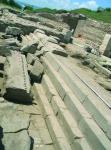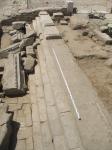Summary (English)
HERACLEA SINTICA (Lyudmil Vagalinski – lvagalin@techno-link.com) During the II occupation period, which ended with a fire that occurred soon after AD 276, metallurgical workshops were situated in the northern periphery of the forum. During the III occupation period, the forum was reconstructed with spolia. Fifteen parallel rooms arranged in a line were built along its northern periphery. Some of the rooms were sanctuaries, one of them devoted to Nemesis. The rooms were decorated with multicolor plaster and marble veneer. There were staircases at the both sides of the line of parallel rooms, leading from the forum towards the acropolis. A portico with a three-step stylobate, parallel to the rooms, was situated to the south of them. It led towards the area of the forum paved with stone slabs. There was a civic basilica at the western end of the portico and a public building at its eastern end. During the IV or the V occupation period, the public building was transformed into an Early Christian basilica; an apse was added to the eastern side of the building and walls separating the aisles were built in its interior. A strong earthquake occurred after AD 388, followed by a major flood caused by Strumeshnitsa River. Subsequently, the inhabitants of the town used the civic basilica and most of the parallel rooms for houses. Another earthquake that occurred soon after AD 425 ended the IV occupation period. A small gold chain lost during the earthquake was found in one of the parallel rooms. The V occupation period began soon after AD 457. Some of the parallel rooms were reused for houses. A Late Hellenistic inscription mentioned a theater that existed in the town. An honorary inscription of the 2nd century AD shows Roman influence on the Graeco-Macedonian names. An epitaph testified that the town flourished during the 2nd century AD. During II – IV occupation periods, the bones from oxen, sheep/goats and pigs prevailed and oak timber was used in the structure of the buildings. Heraclea Sintica was the main settlement center in the Middle Strymon River Valley from the second half of the 4th century BC to the second half of the 5th century AD.
- Lyudmil Vagalinski - Archaeological Institute with Museum
Director
Team
Research Body
- Archaeological Institute with Museum






![Download [PDF]](/excavation/skins/fasti/images/results/download_sml.png)

